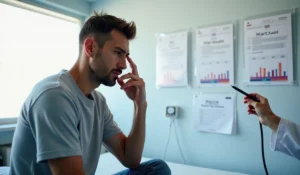Many women suffer from high testosterone symptoms, yet doctors fail to diagnose this condition that affects 5-10% of women during their reproductive years. Most people link testosterone to male traits, but women’s bodies also produce this hormone in smaller amounts. The normal range stays between 15 to 70 nanograms per deciliter. Health problems can develop if levels rise above this range.
High testosterone levels create various physical and emotional changes in women’s bodies. These changes range from irregular periods and excess facial hair to mood swings and unexpected weight gain. These symptoms can affect a woman’s quality of life by a lot. Healthcare providers might overlook these side effects or confuse them with other conditions. Women can get proper treatment only when we are willing to spot these warning signs their doctors might have missed.
7 Warning Signs of High Testosterone in Women
Women often find it hard to spot high testosterone symptoms because they share similarities with other conditions. These warning signs usually develop slowly, which makes them easy to overlook. Let’s get into seven key signs that might show your body has elevated testosterone levels.
1. Irregular or missed periods
Your menstrual irregularities substantially relate to high androgen levels, even when you’re otherwise healthy [1]. The symptoms range from longer cycles to missed periods or unpredictable menstruation patterns. Your body’s normal hormonal balance gets disrupted when testosterone interferes with ovulation and menstrual regularity.
2. Excess facial or body hair (hirsutism)
About 5-10% of women in their reproductive years experience hirsutism [2]. This condition makes coarse, dark hair grow in typically male patterns—especially on the face, chest, abdomen, and back. Research shows that 70-80% of hirsutism cases link to PCOS [2], though other conditions that lift testosterone can trigger this symptom.
3. Persistent acne or oily skin
Scientists discovered that 72% of women with acne had excess androgen hormones, including testosterone [3]. Your skin produces more sebum when testosterone levels rise, which leads to oilier skin and stubborn acne. These breakouts often appear along the jawline and chin area and resist standard treatments.
4. Deepening of the voice
Your voice might change as testosterone levels increase, though timing varies greatly. Research on women receiving testosterone therapy showed vocal changes occurred anywhere from immediately to 48 months after treatment started [4]. The changes to your vocal cords from testosterone often become permanent.
5. Thinning hair or male-pattern baldness
Androgenic alopecia starts when high testosterone causes gradual thinning at the part line and spreads to diffuse hair loss from the head’s top [5]. This happens because testosterone makes hair follicles shrink, which results in shorter, thinner hairs.
6. Unexplained weight gain or increased muscle mass
Your body tends to store more visceral fat around the abdomen when testosterone rises, and insulin resistance increases. Studies show women on testosterone gained substantially more lean body mass—923g compared to 135g in the control group [6]. You might notice stronger muscles and changes in your body composition.
7. Mood swings or increased irritability
Your brain’s neurotransmitters can change when testosterone levels exceed normal ranges. Common emotional changes include irritability, anxiety, and depression [7]. These mood shifts often make it challenging to connect symptoms to hormonal changes.
What Causes High Testosterone in Women?
Several medical conditions can disrupt normal hormone balance and cause high testosterone in women. A proper diagnosis and treatment requires understanding these causes.
Polycystic ovary syndrome (PCOS)
PCOS affects 4% to 12% of women during their reproductive years [8] and stands as the most common cause of ongoing hyperandrogenism, making up 80% to 90% of cases [9]. The condition creates a hormone imbalance where high insulin levels make the ovaries produce too much testosterone [10]. High testosterone disrupts follicle development and stops normal ovulation [10]. The condition creates a cycle where testosterone increases insulin resistance, which then drives up testosterone production even more [11].
Congenital adrenal hyperplasia (CAH)
Genetic mutations that affect adrenal hormone production enzymes cause CAH [12]. The most common type, 21-hydroxylase deficiency, shows up in about 1 in 12,000 live births for classic CAH and 1 in 2,500 for nonclassic CAH [12]. Low cortisol levels trigger increased ACTH production, which then drives up adrenal androgen production [13]. Nonclassic CAH accounts for about 2% of female hyperandrogenism cases [9].
Ovarian or adrenal tumors
Androgen-secreting tumors are rare but make up about 0.2% of hyperandrogenism cases [9] [14]. These tumors can start in the ovaries or adrenal glands. Sertoli-Leydig cell tumors are among the ovarian tumors that produce excess testosterone, making up less than 0.5% of ovarian neoplasms [15]. Adrenal tumors that only produce testosterone without raising other adrenal androgens are very rare [16].
Insulin resistance and obesity
Insulin resistance significantly affects testosterone levels [8]. High insulin levels make the ovaries produce more testosterone while reducing sex hormone-binding globulin (SHBG) production [9]. These changes increase free testosterone in the blood. Upper-body obesity links to insulin resistance, though only 35% to 50% of women with PCOS are obese [8].
Medications and supplements
Some medications can raise testosterone levels unexpectedly [9]. These include anabolic-androgenic steroids, synthetic progestins, and some antiepileptic drugs [9]. Your testosterone levels might also rise if your partner’s topical testosterone therapy transfers to your skin [17].
How Doctors Diagnose High Testosterone
Healthcare providers use a step-by-step process to diagnose high testosterone in females. Medical teams need to understand why it happens before they can recommend the right treatment options.
Physical examination and symptom review
Doctors start with a careful look at visible signs of hyperandrogenism. They check for unusual facial or body hair growth patterns, acne, oily skin, and signs of hair thinning [18]. The way these symptoms develop and progress gives important clues. A quick onset of virilization needs more attention due to possible tumors [19]. The medical team also looks for signs of insulin resistance like skin tags and acanthosis nigricans [19]. Your medical history, including period irregularities and fertility issues, helps create a full picture.
Blood tests and hormone panels
Blood work is the life-blood of diagnosis. Total testosterone measurement proves most helpful, and doctors prefer liquid chromatography/mass spectrometry (LC-MS/MS) for better accuracy [20]. PCOS often shows up in values between normal and 2 ng/dL, while levels above 2 ng/dL might point to an ovarian tumor [21]. The team runs more tests that include DHEAS (levels above 700 μg/dL suggest adrenal tumors), 17-hydroxyprogesterone, and sex hormone-binding globulin (SHBG) [21]. Thyroid function and prolactin levels also need checking since they can affect hormone balance.
Imaging tests like ultrasound
Lab results showing substantial testosterone elevation call for imaging. Transvaginal ultrasound with color Doppler works best as the first imaging choice for suspected ovarian issues [20]. Premenopausal women with total testosterone above 150 ng/dL or postmenopausal women over 64 ng/dL need immediate pelvic imaging [20]. DHEAS levels exceeding 700 μg/dL might require CT or MRI scans to check adrenal glands for tumors [1].
Why morning testing matters
Testosterone levels change throughout the day and peak between 8-10 AM [22]. Studies show morning levels are different from other times (411.7 vs. 368.3 ng/dl) [23]. The quickest way to get accurate results is through morning fasting blood draws. It’s worth mentioning that accurate results need at least three months after stopping hormonal contraception [20].
How to Treat High Testosterone in a Woman
Women with high testosterone can choose from various treatment options that range from medication to lifestyle changes. Their effectiveness depends on the mechanisms at play. Most doctors suggest combining different approaches to manage symptoms better.
Oral contraceptives and anti-androgens
Birth control pills with ethinyl estradiol suppress ovarian androgen production and raise sex hormone-binding globulin. This reduces free testosterone by about 50% [24]. The most effective oral contraceptives to treat hyperandrogenism have low doses of norgestimate, desogestrel, or gestodene [1]. Spironolactone (50-200 mg daily) blocks testosterone’s effects at receptor sites and helps women with persistent symptoms [25]. Doctors usually start with oral contraceptives alone. They add anti-androgens after six months if needed [20].
Metformin and insulin regulation
Metformin helps control blood glucose levels and reduces testosterone production in cases linked to insulin resistance. Studies show that metformin treatment can lower total, free, and bioavailable testosterone levels within three months [26]. Recent research reveals that metformin isn’t as good as anti-androgens at improving hirsutism [27]. In spite of that, metformin remains a valuable option for women who have PCOS and insulin resistance.
Hair removal options: laser, electrolysis
Professional hair removal methods are a great way to get relief from visible symptoms like hirsutism. Laser hair removal uses concentrated light to damage hair follicles. It needs multiple sessions but can give near-permanent results [2]. Electrolysis works by destroying individual hair follicles with electric current. This makes it better suited for lighter hair colors than laser treatments [28].
Lifestyle changes: diet and exercise
Losing just 5-10% of body weight can lower testosterone levels and improve symptoms [1]. High-intensity interval training works better than strength training to reduce serum testosterone levels in women with PCOS [29]. On top of that, eating polyunsaturated fats from flaxseed and fatty fish shows promise in naturally lowering testosterone levels [30].
When to think about hormone therapy
Stronger options exist for severe cases of hyperandrogenism that don’t respond to standard treatments. Gonadotropin-releasing hormone agonists lower ovarian androgen production but can cause side effects like hot flashes and decreased libido [2]. Doctors might recommend surgical removal in rare cases with tumors [9].
Conclusion
Women with high testosterone often show subtle warning signs that doctors might miss. This piece explores symptoms, causes, diagnostic approaches, and treatment options for women with high testosterone levels. Seven key warning signs exist – from irregular periods and hirsutism to voice changes and mood swings. These signs can help you get the right diagnosis faster.
Women often struggle for years without answers because these symptoms look like other conditions. Healthcare providers sometimes dismiss these signs or link them to unrelated issues. PCOS remains the most common cause, but other conditions need a full investigation too. These include congenital adrenal hyperplasia, tumors, and insulin resistance.
Getting the right diagnosis usually needs physical examination, hormone testing, and imaging studies. Your morning test results give the most accurate picture because testosterone levels change throughout the day. Several treatment options work well after diagnosis. Oral contraceptives and anti-androgens help balance hormones, while metformin benefits those with insulin resistance. On top of that, targeted exercise and dietary changes have helped many women substantially.
Living with high testosterone brings challenges, but you can manage it well with proper medical guidance. Trust your body’s signals when you notice these warning signs. Quick action helps reduce current symptoms and prevents long-term health issues from hormone imbalances. You should get answers and proper care for these overlooked symptoms.
References
[1] – https://flo.health/menstrual-cycle/health/symptoms-and-diseases/high-testosterone-in-women
[2] – https://my.clevelandclinic.org/health/diseases/14523-hirsutism
[3] – https://www.healthline.com/health/does-testosterone-cause-acne
[4] – https://pubmed.ncbi.nlm.nih.gov/32386906/
[5] – https://www.health.harvard.edu/staying-healthy/treating-female-pattern-hair-loss
[6] – https://www.reuters.com/article/business/healthcare-pharmaceuticals/boosting-womens-testosterone-can-increase-muscle-mass-and-endurance-idUSKBN1WW2ZJ/
[7] – https://ro.co/health-guide/high-testosterone-in-women/
[8] – https://pmc.ncbi.nlm.nih.gov/articles/PMC1069067/
[9] – https://my.clevelandclinic.org/health/diseases/24639-hyperandrogenism
[10] – https://www.nhs.uk/conditions/polycystic-ovary-syndrome-pcos/causes/
[11] – https://www.clairepettitt.com/blog/how-to-lower-testosterone-for-pcos-a-nutritionists-review
[12] – https://pmc.ncbi.nlm.nih.gov/articles/PMC3066446/
[13] – https://my.clevelandclinic.org/health/diseases/17817-congenital-adrenal-hyperplasia
[14] – https://pmc.ncbi.nlm.nih.gov/articles/PMC10911220/
[15] – https://medcraveonline.com/MOJWH/androgen-secreting-ovarian-tumors.html
[16] – https://pmc.ncbi.nlm.nih.gov/articles/PMC6343319/
[17] – https://www.joinmidi.com/post/how-to-treat-high-testosterone
[18] – https://www.healthline.com/health/high-testosterone-in-women
[19] – https://www.acog.org/clinical/clinical-guidance/committee-opinion/articles/2019/10/screening-and-management-of-the-hyperandrogenic-adolescent
[20] – https://pmc.ncbi.nlm.nih.gov/articles/PMC8548673/
[21] – https://emedicine.medscape.com/article/273153-workup
[22] – https://thischangedmypractice.com/testosterone-testing-male-hypogonadism/
[23] – https://pubmed.ncbi.nlm.nih.gov/26360789/
[24] – https://www.ncbi.nlm.nih.gov/books/NBK164632/
[25] – https://www.nhs.uk/conditions/hirsutism/
[26] – https://pubmed.ncbi.nlm.nih.gov/35002984/
[27] – https://emedicine.medscape.com/article/273153-medication
[28] – https://www.mayoclinic.org/diseases-conditions/hirsutism/diagnosis-treatment/drc-20354941
[29] – https://pmc.ncbi.nlm.nih.gov/articles/PMC9304438/
[30] – https://www.verywellhealth.com/foods-to-lower-testosterone-2616293





